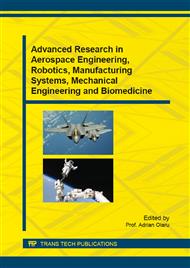[1]
Information on www. aripi-argintii. ro.
Google Scholar
[2]
A. C. Ionescu: Heroes of jets age (Eroii erei reactive), RBA Media Publisher, Bucharest (2014).
Google Scholar
[3]
A. C. Ionescu: Faster than death 1 (Mai iute ca moartea 1), Silver wings (Aripi Argintii) Publisher, Bucharest (2015).
Google Scholar
[4]
A. C. Ionescu: Faster than death 2 (Mai iute ca moartea 2), Silver wings (Aripi Argintii) Publisher, Bucharest (2015).
Google Scholar
[5]
C. Cioaca, M. Boşcoianu: Model of Assessing the Impact of Rare Events in Aviation Security Investments Projects , Applied Mechanics and Materials, Vol. 555 (2014), pp.11-17.
DOI: 10.4028/www.scientific.net/amm.555.11
Google Scholar
[6]
C. A. Read, J. Pillay: Injuries sustained by aircrew on ejecting from their aircraft, Journal of accident & emergency medicine, Vol. 17, (2000), pp.371-373.
DOI: 10.1136/emj.17.5.371
Google Scholar
[7]
D. R. Hunter: Measurement of Hazardous Attitudes Among Pilots, The International Journal Of Aviation Psychology, Vol. 15 (2005), p.23–43.
DOI: 10.1207/s15327108ijap1501_2
Google Scholar
[8]
E. Salas: Human Factors in Aviation, Academic Press (2010).
Google Scholar
[9]
M. Edwards: Anthropometric measurements and ejection injuries, Aviation, Space, and Environmental Medicine, Naval Aerospace and Operational Medical Institute, Naval Air Station Pensacola, FL, USA. Vol. 67 (1996), p.1144.
Google Scholar
[10]
M. Monica: Aviation Psychology and Human Factors, CRC Press (2010).
Google Scholar
[11]
M. Popa: Aeronautical psychology (Psihologie aeronautica), Carol Davila, Press (2005).
Google Scholar
[12]
P. A. Simpson: Naturalistic Decision Making in Aviation Environments, Air Operations Division Aeronautical and Maritime Research Laboratory (2001).
Google Scholar
[13]
W-C. Li. D. Harris, Y-L. Hsu, T. Wang: Understanding Pilots' Cognitive Processes for Making In-flight Decisions under Stress, Proceedings of the 42nd Annual International Seminar: Investigation a Shared Process, Salt Lake City, Utah. (2011).
Google Scholar
[14]
W. R. Knecht: Predicting General Aviation Accident Frequency From Pilot Total Flight Hours, FAA Civil Aerospace Medical Institute Federal Aviation Administration Oklahoma City (2012).
Google Scholar


